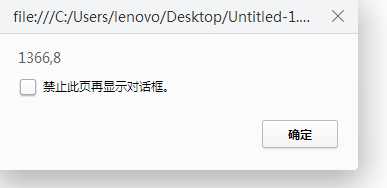标签:
JS DOM 来控制HTML元素
(ps:这个有很多方法,挑一些详解,嘻嘻)
1.getElementsByName():获取name.
~~~~~~~~~~~~~~~~~~~~~~~~~~~~~~~~~~`
例:<p name="pn">hello</p>
<p name="pn">hello</p>
<p name="pn">hello</p>
<script>
function getName(){
var count=document.getElementsByName("pn");
alert(count.length);
var p=count[2];
p.innerHTML="world";
}
</script>
结果:界面打印出三个hello,并且伴有一个提示框“3”,当点击确定后,界面显示的内容变为hello hello world
~~~~~~~~~~~~~~~~~~~~~~~~~~~~~~~~~~~~~~~~~~~~~~~~~··
2.getElementByTagName():获取元素。
~~~~~~~~~~~~~~~~~~~~~~~~~~~~~
例:<p>hello</p>
<p>hello</p>
<p>hello</p>
<script>
function getName(){
var count=document.getElementsByTagName("p");
alert(count.length);
var p=count[2];
p.innerHTML="world";
}
</script>
结果:界面打印出三个hello,并且伴有一个提示框“3”,当点击确定后,界面显示的内容变为hello hello world
~~~~~~~~~~~~~~~~~~~~~~~~~~~~~~~~~~~~~~~~~~~~~~~~~~
3.getAttribute():获取元素属性。
~~~~~~~~~~~~~~~~~~~~~~~~~~~~~~~~~~
例:<a id="aid" title="得到a的标签属性"></a>
<script>
function getAttr1(){
var anode=document.getElementById("aid");
var attr=anode.getAttribute("id");
alert("a的ID是:"+attr);
}
function getAttr2(){
var anode=document.getElementById("aid");
var attr=anode.getAttribute("title");
alert("a的title内容是:"+attr);
}
getAttr1();
getAttr2();
</script>
结果:弹出提示框“a的ID是:aid”.点击确定后,弹出提示框“a的title内容是:得到a的标签属性”。
~~~~~~~~~~~~~~~~~~~~~~~~~~~~~~~~~~~
4.setAttribute()设置元素属性。
~~~~~~~~~~~~~~~~~~~~~~~~~~~~~~~~~~~~
例:<a id="aid2">aid2</a>
<script>
function setAttr(){
var anode=document.getElementById("aid2");
anode.setAttribute("title","动态设置a的title属性");
var attr=anode.getAttribute("title");
alert("动态设置的title值为:"+attr);
}
setAttr();
</script>
结果:弹出提示框“动态设置的title值为:动态设置a的title属性”。
~~~~~~~~~~~~~~~~~~~~~~~~~~~~
5.childNodes():访问子节点。
~~~~~~~~~~~~~~~~~~~~~~~~~~··
例:<ul><li>1</li><li>2</li><li>3</li></ul>
<script>
function getChildNode(){
var childnode=document.getElementsByTagName("ul")[0].childNodes;
alert(childnode.length);
alert(childnode[0].nodeType);
}
getChildNode();
</script>
结果:界面打印出.1 .2 .3弹出对话框“3”,按确定后弹出“1”。
~~~~~~~~~~~~~~~~~~~~~~~~~~~~~~~~~~~~~~~~
6.parentNode():访问父节点。
~~~~~~~~~~~~~~~~~~~~~~~~~~~~~~~~·
例:<div>
<p id="pid"></p>
</div>
<script>
function getParentNode(){
var div=document.getElementById("pid");
alert(div.parentNode.nodeName);
}
getParentNode();
</script>
结果:弹出提示框:DIV.
~~~~~~~~~~~~~~~~~~~~~~~~~~~~~~~~~~
7.createElement():创建元素节点。
~~~~~~~~~~~~~~~~~~~~~~~~~~~~~~~~
例:
<script>
function createNode(){
var body=document.body;
var input=document.createElement("input");
input.type="button";
input.value="按钮";
body.appendChild(input);//插入节点
}
createNode();
</script>
结果:出现一个按钮。
~~~~~~~~~~~~~~~~~~~~~~~~~~~
8.createTextNode():创建文本节点。
~~~~~~~~~~~~~~~~~~~~~~~~~~~~~~
例:
<script>
function createNode(){
var element = document.createElement("div");
element.className = "message";
var textNode = document.createTextNode("Hello world!");
element.appendChild(textNode);
document.body.appendChild(element);
}
createNode();
</script>
代码分析:这个例子创建了一个新<div>元素并为它指定了值为“message”的class特性。然后,又创建了一个文本节点,并将其添加到前面创建的元素中。最后一步,就是将这个元素添加到了文档中的<body>元素中,这样可以在浏览器中看到新创建的元素和文本节点了。
结果:页面显示hello world。
~~~~~~~~~~~~~~~~~~~~~~~~~~~~~~~~~~~~~~~~~~~
9.insertBefore():插入节点。
~~~~~~~~~~~~~~~~~~~~~~~~~~~~~~~~
例:<div id="div">
<p id="pid">p元素</p>
</div>
<script>
function addNode(){
var div=document.getElementById("div");
var node=document.getElementById("pid");
var newnode=document.createElement("p");
newnode.innerHTML="动态插入一个p元素";
div.insertBefore(newnode,node);
}
addNode();
</script>
结果:界面打印出:动态插入一个p元素
p元素
~~~~~~~~~~~~~~~~~~~~~~~~~~~~~~~~~~~~~~~
10.removeChild():删除节点。
~~~~~~~~~~~~~~~~~~~~~~~~~~~~~·
例:<div id="div">
<p id="pid">p元素</p>
</div>
<script>
function removeNode(){
var div=document.getElementById("div");
var p=div.removeChild(div.childNodes[1]);
}
removeNode();
</script>
结果:界面什么也没显示。
~~~~~~~~~~~~~~~~~~~~~~~~~~~~~~~~~~~
11.offsetHeight:网页尺寸
12.scrollHeight:网页尺寸
~~~~~~~~~~~~~~~~~~~~~~~~~~~·
例:
<script>
function getSize(){
var width=document.documentElement.offsetWidth||document.body.offsetWidth;//解决兼容问题
var height=document.documentElement.offsetHeight||document.body.offsetHeight;
alert(width+","+height);
}
getSize();
</script>
显示结果:

标签:
原文地址:http://www.cnblogs.com/yanyuanyuan/p/5722787.html